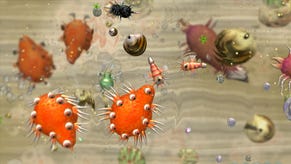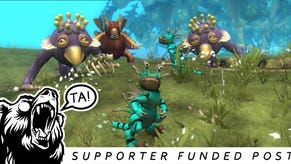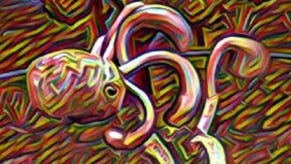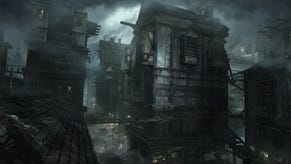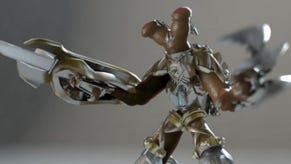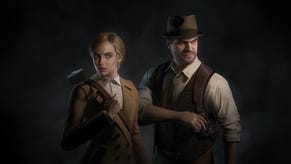Spore: It's Made Of People
[Brandon Boyer, the author of this piece, is one of Rock, Paper, Shotgun's international agents. In 2006 he visited Spore developers Maxis at their studio on behalf of Edge magazine. The following article is an updated version of the feature that was published in that magazine last year. In it Mr Boyer talks to Wright and his team, and gets the heart of how this game came to be. Read on to discover how Spore was made of people.]
I originally visited what I was instructed at the time to refer to as "Spore Group" (but has continued to retain its original Maxis name since) in the summer of 2006, which, referring to Wired magazine's recent timeline, puts the game at a point when it had just earned itself nearly a year of additional development – one we now know would extend itself over a year more.
It was also precisely when Brian Eno's involvement had been announced via a Long Now Foundation talk, which, coincidentally, I had stayed up all hours the night before to listen to, and subsequently found myself in state of gentle delirium for the visit proper, a state not eased by the sharpness of the minds behind Spore: Will Wright's infamous ability to jump from one end of a cultural/scientific extreme to the next via a segue that only comes clear on later, deeper introspection, and tech lead Chris Hecker's similarly notorious lightyear-a-minute speech pattern compounded by the wide algorhythmic stride of his own mathematical mind.
What I found there, though, was a game still under day-to-day expansion beyond the galaxies it had already created, a team still dynamically morphing and terraforming its near-limitless landscapes, and revealing aspects that have still to date gone relatively untouched – interspecies relationships, rare Maxis-custom-created 'storybook' planets giving players a more whimsical experience than its generative formulae allow, and a creator still working out the million dollar question: will its sci-fi leanings limit its universal appeal?
Since then, Creature Creator user data has addressed that latter issue, with EA head John Riccitiello himself recently expressing surprise at the one-third female downloaders of the early-release trial. At the same time, Riccitiello also hinted at the game's microtransactional future – a Sims Store-like marketplace of new parts for Spore's various editors – an idea that was in the breeze during my visit but that I was made to un-remember with a wave of a Maxis mind-control wand, and was previously officially denied, but seems now to surely be in the cards.
Other details have since cropped up and are looming as lusciously large as the game's ever-nearing release date: massive 'epic' creatures that can be killed for special bonuses and eventually be player-created, the ability to domesticate creatures as the Tribe level, trade routes, resource harvesting at Tribe and Civ levels once evolution has been locked down, and controlling entire fleets of allied ships as you make your way across the universe.
Just what other surprises Maxis has in store will remain secret in the short few weeks before the game is released, but the feature below, originally written for Edge magazine, brings more clarity with a look back at where Spore has come from, and the stuff it's made of.
His office is as you would expect it would be – covered top to toe with maps of the solar system, remote controlled toy robots, books, and scribbled notes expanding even to the glass door onto his office patio. We're here in an attempt to get to wrap our minds around everything, by which we mean Everything. Its surprise debut at the 2005 Game Developer's Conference left the standing-room-only full-house crowd to spread hushed disbelieving "did you see it, too?" sentiments and covert blurry cell-phone photos across the internet, all of whom were left unable to fully express in words the potential magnitude of what they'd just witnessed, and each subsequent demonstration has only added more to think about, more to see, more to digest.
Despite former grandiosity, the expansiveness and infinitesimal minute detail of the Sims that came before it now seeming like a simple twinkle in Spore's placeable and replaceable segmented, stalked, or long-lashed eyes, Will Wright sits sideways in his office chair, effortlessly ready to field any question, knowing that there isn't any space in his Space he hasn't already traveled through before.
For a game which 'sim's life, the universe, and everything in between – every bit the culmination of decades' worth of those now bite-sized pieces – and which is modestly innovating on a number of fronts from its player-driven generative technologies to its "massively single player" pollinated content, ask Wright what he's most proud of and you might expect a litany of engineering achievements. But it's not: it's the people.
"The team," he answers, without even thinking, "It's a hand-picked team of people, where I was cherry-picking the best in the company. Because of that, what seemed like an impossible design at the beginning started to seem probable, and then likely, and now positive, and at every turn the team has exceeded my expectations about what they could deliver both technologically and design-wise."
An elevator ride down from Wright's office to the main studio illustrates that point as we find ourselves in the midst of an accidental impromptu design meeting, with art director Ocean Quigley describing the look and feel of a new UFO component using nothing but a series of wild reverberating hand gestures and accompanying mouth sounds. Wright looks on, quietly generating the scene in his mind, and in the end, just as the first-floor bell dings, gives the idea his seal of approval. As the elevator quietly empties, we wonder: is that as easy as it is to add new functionality? "With Ocean, yes," answers Wright.
Quigley's task on Spore might at first seem a daunting one – art directing an entire galaxy a few million planets-strong, and one which he admits is only possible by relentlessly iterating and prototyping a million little pieces of problems individually, but add to that the game's inversion of the traditional studio balance, with an art team a third of the size of earlier Sim titles being driven by an engineering team already larger than Sims 2, and his particular role becomes even
more esoteric.
"Normally I'm art directing artists, but this is a game where I'm spending all my time art directing engineers. It's not the artists who are making this directly, it's the engineers that are making the systems, so you have to figure out what you need to do to make it so that a player or procedural system can make something like this" – he picks up one of the 3D printed creature figurines that litter the desk – "quickly and easily. It's kind of freakish in that regard – usually, I'm telling the artists 'make it bluer,' but here you're telling the engineers, 'can we get some way to seam these two things together procedurally,' or 'we need to run an ambient occlusion pass on this so the shadows sync up.' So, it's an odd job."
With so much left to the unpredictable hands of players, and the game's machinery driving every bit of its visual content, we ask Quigley – coming off titles like SimCity 4 where designers had full control of the world down to the pixel – if he's confident that Spore's structures are rigid enough to handle the near infinite possible permutations, or if he worries about players deviating from the norm.
"Well, the whole sandbox ideology for games is predicated on the player diverging, so if the player doesn't diverge we've wasted so much work" – he buries his face in his hands – "Oh my god, the player damn well better diverge. Otherwise we could have just given them a level game.
"There are edge cases, of course, where players might push themselves into corners where stuff behaves badly or unexpectedly, but I'm not worried about that. In fact, that's where we're figuring the majority of the long term replayability of the game is, if it's just" – he rockets his arm straight forward through the air with an accompanying thhbpt – "and you're done with the game, great. But we're hoping – if it's anything like SimCity or the Sims – that people do that for 8 or 10 hours and then wonder, 'hmm, I wonder what would have happened if I'd done that at that point,' and will explore the branching and the state space of what the game provides, both in terms of things that you can build and things you can manipulate in your direction – creatures, or other civilizations."
"We don't for the most part author levels; rather we have made machines that make levels. When you come down to a planet, part of the challenge that we're dealing with is making those visually compelling, so you're not like 'oh, another one.' You really want to see something where you feel like there's intelligence behind the aesthetic decisions, and of course, make them viable gameplay levels, so if you go to a planet, the interaction isn't just 'oh, it's pretty… Ok, I'm going.' That's something that's a bear of a problem and something that we're still chewing on and manipulating."
At the other end of the design spectrum, Spore's engineers are busy at work on a similarly Herculean task: attempting to provide a standard set of meshed-up keyframed and algorithmic creature animations to cover the player's near-infinite range of creative freedom. In the group's bespoke animation program, appropriately titled SPASM, technology fellow and animation team lead Chris Hecker manipulates an intergalactic identity parade of creatures great and small, grabbing what would approximate one's hand and swinging it into a right-hook attack, with the full line-up attempting in turn their similar attacks, with whatever appendages they have at their disposal.
Hecker explains that with the exponential impossibility of custom fitting movement for every case, failure, in Spore terms, isn't necessarily a non-option. "One of Will's themes that we're depending on heavily is 'if you're going to fail, fail funny.' The hope is if you start making some crazy-ass creature, like this guy" – he swings SPASM's view to an unnaturally asymmetrical decapod-plus – "has 11 legs. You have no idea how an 11 legged creature would walk, so if he stumbles over himself, it's like 'hey, that's on purpose.' If we can hit one animation that works for 80 percent of the creatures, do a couple others that suck up the last 15 percent, and the remaining five percent fail humorously, then we're golden."
As we're given another look at the quick-stop zip-compressed tour through Spore's outwardly expanding universe, we're struck once again with both the awe at its immensity and the irresistible wanderlust it's pull-out spiral arms inspire, but also with the sense of its enormity that's left to be implemented. Two years in design, but only recently under full development, the gameplay in Space, the final frontiering section of Spore, is hinted at with new inter-species dialogues brought up when planetary neighbors complain of their homeworld being attacked after an accidental war is instigated.
How much more of that diplomacy and negotiations can be expected? "Quite a bit more," Wright explains. "Actually, we're going to have inter-stellar alliances, and you're going to be able to interact with any level of planet that you come across, from barren, to wild, to tribal, city, civ – each one's going to have kind of different game dynamics.
"Once you get into interacting with other space-faring races, it's a broader palette of options. At that point, you can choose to attack them, form an alliance, trade, or get missions – there'll be missions generated at that level. But I think the relationship game at the interstellar level is going to be an elaboration of the relationship game that we have down at the civilization level, where I have a nation with good or bad relationships: I might be trading partners with these guys, I might be culturally trying to influencing these guys, and attacking those guys, all the way back to the tribal level where it's very simple little interactions between the tribes. This relationship structure, that starts at the tribal level in a very simple way, gets elaborated into city, civ, and then into space where it probably gets the most elaborate."
Is that interstellar exploration always the ultimate goal of the game, or can players have equally rich experiences at lower levels? "The advancement between levels is always optional for the player, the player is the one that pulls the trigger on the advancement, so if they want to stay at creature level they can stay there as long as they want to. It's up to them to pull the trigger on advancing to tribe. We fully expect that certain players will enjoy certain levels more than others, and also once you get to Space game you can in some ways revisit levels from that point of view, so if you really enjoyed he creature ecology game you can genetically engineer creatures for free now in the editor and use them to populate worlds."
Coming off the back of the Sims series, whose domestic themes in part managed to garner it its best-selling audience, we try to pin down whether its sci-fi underpinnings might be potentially off putting to a more casual audience. "You never know," he confesses, "When I was first pitching the idea for the Sims and it was about taking out the trash and cleaning the toilets, everybody said that's exactly what would fail – it's too domestic, why would anyone want to play that game? Now, looking back on the Sims, it's like well of course it's a success, because it's about domestic life.
"I think it's almost more about accessibility, so that somebody without a lot of knowledge of Tolkien or D&D or military history can come in, start pressing buttons and having an enjoyable time, and then learn the game. Even though the themes seem kind of science-y, people understand roughly the way creatures move around, a little bit about evolution, a little bit about astronomy, but it's not required at all.
"The primary thing is it needs to be something where they're getting instant reward, that they don't have a hardcore NPC coming and kicking their butt every 5 minutes, and that they can go off in the direction that they want to go off. That might be the creative direction of spending a lot of time decorating their creature, it might be the strategy direction of tuning their city just right and doing the layout, or it might be the more like MMO experience in the UFO, going around collecting rares and trading."
That Wright has a deeper modus operandi than simply funny fiction with Spore was hinted in his whirlwind of a lecture at this year's Game Developer's Conference, and again, when elucidated, the underlying message that it's about people – a game made by people for people to make the game – becomes all the more clear. "I think a more personal message, is that everybody has in some sense a universe inside of them, in their imagination, that with the right toolset they can pour it out and instantiate it. I just like the idea that every person is going to create their own unique universe in the game, bit by bit, creature by creature, building by building, eventually they'll step back and say 'wow, I've created this entire world,' which to me is very powerful.
"The first time I ever played Myst, this beautifully rendered world, I was moving around and the first thing that occurred to me was: you know, somebody had a blast building this world, and I would love to have the toolset to build a world like that. I think that's a deeper message, that everybody has more creativity in them that they think they have."
And after the completion of Spore, his SimEverything, what's left to Sim? "Nothing. Sim nothing, I've always wanted to do SimNothing. Wouldn't that be a great game?"











